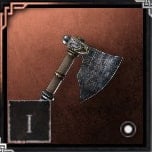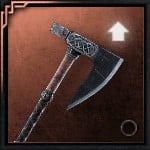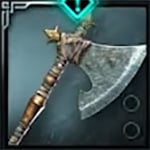Reviewing video game weapons isn't something we've done before, as we are usually doing research on how historical pieces were actually made and used. But since I've been playing this game a bit during our COVID winter, I thought I'd write up some thoughts on the weapons in the game. I'm doing this not to make fun of the inaccuracies in the game, but to give folks whose interest might be piqued through playing some fun facts about the real deal. Also, if you want some real, historically accurate, and top quality medieval axes, we make them. This is the first in a series on the various weapons featured in Assassin's Creed Valhalla.

The 2020 video game "Assassin's Creed Valhalla" has spurred a lot of interest in Viking Age weapons and Armor. The game features a wide array of fighting axes that can be used by the main character in combat. We thought we'd take this opportunity to talk a little about fighting axes of the Viking period, and how the weapons in the game match up to the real history of Viking axes. For the purposes of this article we will define the Viking Age in England as the rough period between about 793 AD, when the Abbey at Lidisfarne was raided, and 1066, when the Norman conquest of England and the Battle of Hastings put an effective end to the Dane Law.

In the game the weapons are clearly fantasy influenced, with bulkier and heavier blades than are actually historical, but this is pretty common in video games as a way to make sure that the weapons are visible at all angles. Basically, if you made them the correct dimensions they would be difficult to see from the edge. Playing the game you start out with a one-handed, bearded axe. These were a common tool and weapon during the Viking period, though the real examples differed quite a bit from many of those in the game. I've included some pics of a few of the more realistic 'bearded axes' from the game, though the one below looks more like a much later "Lochaber Axe" style pole arm.

The 'beard' on an axe is the portion of the cutting face that extends below the axe socket. This is most easily seen if you compare one of these axes to modern wood axes, which are rarely bearded. For example, the modern axe below.

Many Viking period axes really were bearded, and this iconic shape served a couple of important functions. First of all, iron was relatively expensive, and smiths could save material on an axe by forging out the beard below the socket without losing significant strength. If you compare the above axe to our Nordland Axe below, you can see that the bearded shape saves perhaps 25% of the material it would take to make the axe head solid. For the average Viking period farmer, this axe might be one of the only iron implements they could afford, so it was essential that it be as inexpensive as possible and serve double duty as both a tool and a weapon.

Since bearded axes typically use less iron than comparable non-bearded axes, they are also significantly lighter, making them much more wieldy and useful as a weapon. Whereas wood axes are designed to be swung downward or sideways, with full force, toward an immobile target, the ability to quickly stop a cut, make a feint, or change lines of attack is not needed. When fighting a real foe with an axe, however, the ability to easily accomplish such things is literally, a life or death situation. The bearded shape was also useful when fighting with an axe and a shield, as the beard forms a hook that appears to have been used during the Viking period to hook and control the opponents shield, thereby opening them for a thrust or hew.

Custom Type A Combat Axe
However, not all one-handed Viking period fighting axes were significantly bearded. Many others featured a highly peaked point that could be used for thrusting. An excellent example of this type of axe is the Arms and Armor Type L Fighting Axe, pictured below. This axe is a dedicated fighting axe rather than a dual purpose fighting/forestry tool, like many smaller bearded axes appear to have been. The primary difference between dedicated fighting axes and dual use tools is the thickness of the blade. Fighting axes tended to have thinner blades than axes designed to being repeatedly smashed against trees. Instead, these thin-bladed fighting axes were more similar to swords or cleavers, as they were really 'meat axes'. This is what allows them to cut so efficiently. Check out this video of me cutting rolled tatami mats with our Type L Fighting Axe.
Fighting axes were a higher prestige weapon because they had little use beyond combat. Our example, below, features a mild steel socket with a differentially hardened steel blade - a historically accurate pattern.
 The Arms and Armor Type L Fighting Axe
The Arms and Armor Type L Fighting Axe
Overall, several of the bearded axes from Assassin's Creed Valhalla have some resemblance to the historical weapons from which they were inspired, although the game designers have added a bunch of extraneous decorations to the grips that are probably not very historical.

Custom Type D Axe by Arms & Armor
The second category of axes in Assassin's Creed Valhalla are Dane Axes. These are large two-handed axes with large cutting surfaces. Like the Type L Fighting Axe above, these were dedicated fighting axes that were relatively lightweight, fast, and featured a truly terrifying cutting capacity when used against other people. While most of the Dane Axes in Assassin's Creed Valhalla appear quite bulky and heavy, and some of them have pretty fanciful shapes, several of them are reasonably accurate to real historical pieces.



Dane Axes were definitely a real historical weapon, you can see a representation of a couple in this segment of the 11th century Bayeux Tapestry below.

A close up of axes from the Bayeux Tapestry
Some of the axes from the game also appear to have metallic handles, something that really didn't happen in the Viking period, although, again, there were historical examples of axes with metal hafts, such as our Horseman's Axe, that appeared in the late Medieval and Renaissance periods half a millennium after the game is set (here is a link to a video spotlight examining this weapon). Additionally, these were typically much smaller axes than Dane Axes, because a giant axe with a heavy metal haft usually makes an unwieldy and crumby weapon in real life.

Arms and Armor Horseman's Axe, all steel construction
Dane Axes are definitely an intimidating weapon due to their size, but they are also exceptionally dangerous due to how quick and agile they can be. Historical examples of these axes show that the blades were often very thin, and the heads quite light. Check out this article from the leading Viking period historical group, Hurstwic, which features archaeological finds along with some of our reproductions.

For a cool review of our axe, along with some video of cutting demonstrations check out this review by Skallagrim. We also make a large size Type L War Axe, seen below, and here is a video spotlight examining it. Both of these axes are over four feet long and the Danish Axe features a massive ~10.5 inch cutting face. Despite the size of this axe it only weighs about 3 pounds, making it fearsome and fast.

Overall, the Dane Axes in Assassin's Creed Valahalla are a bit less historically accurate than the one-handed axes in the game, largely because they are portrayed as very heavy weapons, which couldn't be further from the truth. However, it's a video game and I understand why they made this decision.
We hope you've enjoyed our little exploration of the in-game axes. If you'd like to see more of our historically accurate, fully functional viking axes, check out our website.

Nathan Clough, Ph.D. is Vice President of Arms and Armor and a member of the governing board of The Oakeshott Institute. He is a historical martial artist and a former university professor of cultural geography. He has given presentations on historical arms at events including Longpoint and Combatcon, and presented scholarly papers at, among others, The International Congress on Medieval Studies.
Craig Johnson is the Production Manager of Arms and Armor and Secretary of The Oakeshott Institute. He has taught and published on the history of arms, armor and western martial arts for over 30 years. He has lectured at several schools and Universities, WMAW, HEMAC, 4W, and ICMS at Kalamazoo. His experiences include iron smelting, jousting, theatrical combat instruction and choreography, historical research, European martial arts and crafting weapons and armor since 1985.
